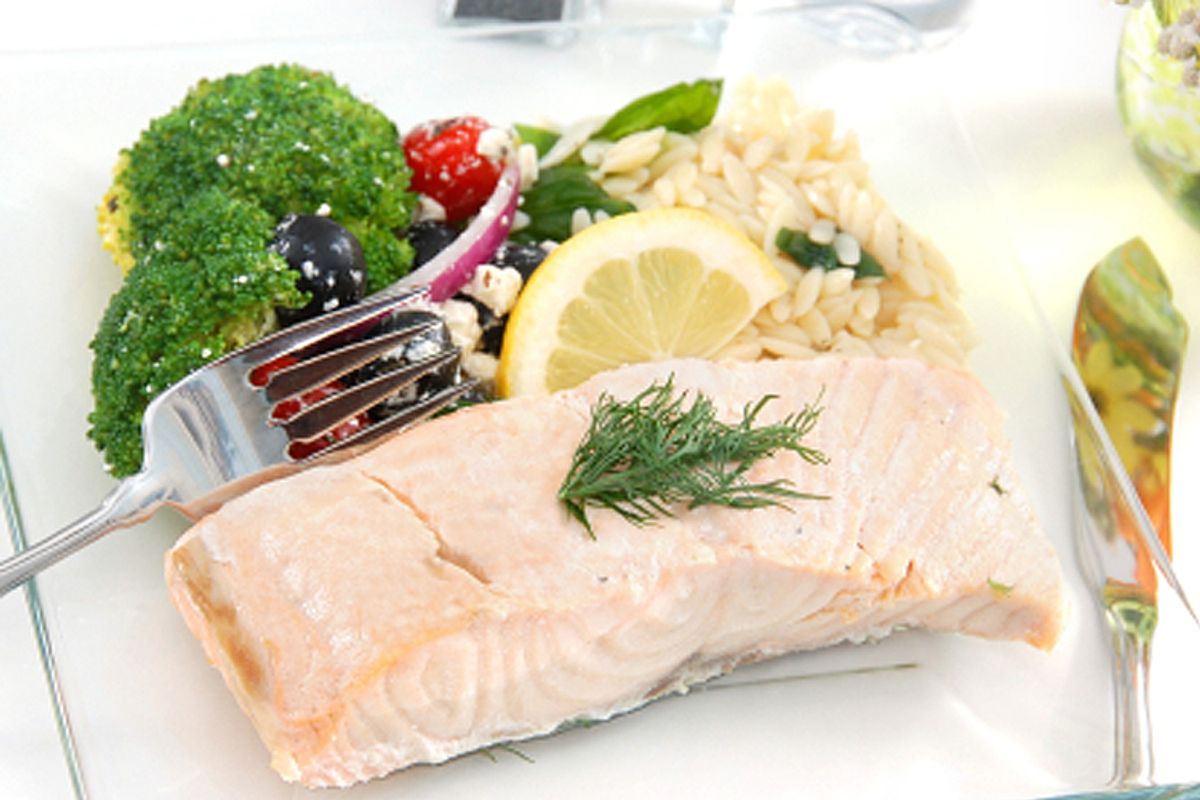Trout is delicious but always a minefield of tiny bones. Tuna is too redolent of the tuna sandwiches in my school lunches. You have to fight a cracked crab, and lobster disagrees with me. But I can't remember a time when I didn't love salmon. It has never let me down. Salmon is so delicious in and of itself and is such a pretty color when cooked, that I believe it benefits most from being cooked simply and allowed to shine as an entrée in its own right. So, sorry, no salmon mousse, soufflé, pasta or croquettes from me.
My two favorite ways to prepare salmon are broiling or poaching. To broil it, all I do to it is squeeze some lemon over each piece, sprinkle it with salt and pepper and then push it under the broiler for about seven to 10 minutes on a side -- an easy dinner even for a weeknight. I confess, I usually have some mayonnaise right out of the jar with this, along with some lemon juice, salt and pepper.
For this kitchen challenge, I decided I'd buy a good bottle of white wine and make a real court bouillon for poaching my salmon. Thus, I invested in a bottle of Vouvray, delicious, clean and mellow enough to slip right down my throat. It's under $20 a bottle -- an indulgence, yes, but not to the tune of "We're drinking Junior's college fund."
Until I started researching recipes, I'd thought the "court" in court bouillon referred to a method of poaching employed at the French royal court. Turns out the "court" is French for "short," as in "boiled for a short period of time." Shame on me for having forgotten so much of my high school French. I did like the image of some King Louis the Umteenth enjoying his poached salmon, though. I think even the pampered crowd at Versailles would have enjoyed a nice piece of poached fresh salmon on their golden plates.
When one poaches fish in a bouillon, it's a low-heat but fairly quick cooking method that renders the salmon very moist and tender and infuses it with flavor. You really pamper that fish. Court bouillons start with a combined base of water and white wine, into which you put aromatic vegetables such as carrots, onions and celery -- aka mirepoix, the Holy Trinity of French cooking -- salt, whole peppercorns, lemon juice or vinegar, and the herbs and seasonings of your choice, and simmer it for less than an hour. Making the bouillon itself is the longest phase, but not at all difficult. And once you poach the salmon in it, it quickly becomes a richly flavored sauce.
Poached salmon with sauce Veloute
Serves 2-4
Ingredients
Court bouillon
(If you're cooking a whole salmon in a fish poacher, you'll want to multiply all of these quantities until you get enough liquid to cover the fish)
- 2 cups cold water (ideally, filtered, such as from a Brita water pitcher)
- 2 cups Vouvray or other white wine
- 1 scrubbed but unpeeled carrot, cut into large chunks
- 1 small leek, white and light green parts only, cut into largish pieces and well rinsed
- 2 teaspoons coarse sea salt
- 1 teaspoon whole peppercorns
- 1 shallot quartered
- 3 stems fresh tarragon
- Juice of ½ lemon
- Strips of lemon zest removed with a vegetable peeler, to taste
Salmon and sauce
- 1 pound salmon fillet
- 1 tablespoon butter, plus more for buttering dish
- 1 tablespoon flour
- heavy cream, to taste, optional
- lemon juice, to taste
- 1 tablespoon capers, optional
Directions
- Combine all court bouillon ingredients in a saucepan and bring to a boil. Turn down to a simmer and cover, leaving a crack, and let simmer for 30–45 minutes.
- Preheat oven to 225 degrees.
- After simmering, strain the court bouillon, keeping the broth hot.
- Butter a baking dish just a bit bigger than you need to fit the fillet, and set the fish in it. Season salmon lightly with salt and pepper, but remember the bouillon will be salty. You can always add more salt later.
- Reheat your strained bouillon until it just starts to bubble around the edges, then pour it over the fish until entirely covered. Cover, if it has a lid, or if not, make a loose tent with foil or parchment over the dish. Set the baking dish in the oven for 12 minutes. Allow another 5 minutes per inch thickness of fish. You want the salmon to still be a little underdone at the center, because it will continue to cook for a few minutes as it rests, thanks to the residual heat.
- Take the fish out of the baking dish, set it on a plate, moisten with a little broth, cover and keep warm while you make the sauce.
- In a saucepan over medium heat, melt the butter and cook the flour, stirring, for a few minutes, until it begins to take on a pale yellow color. Whisk in the poaching liquid a little at a time, until you've made enough for a generous pool of sauce for each diner. Add some cream if you want to make it richer. Keep adding and stirring and, most important, tasting, until you're happy with it. Lemon juice or capers perks up this sauce nicely.



Shares